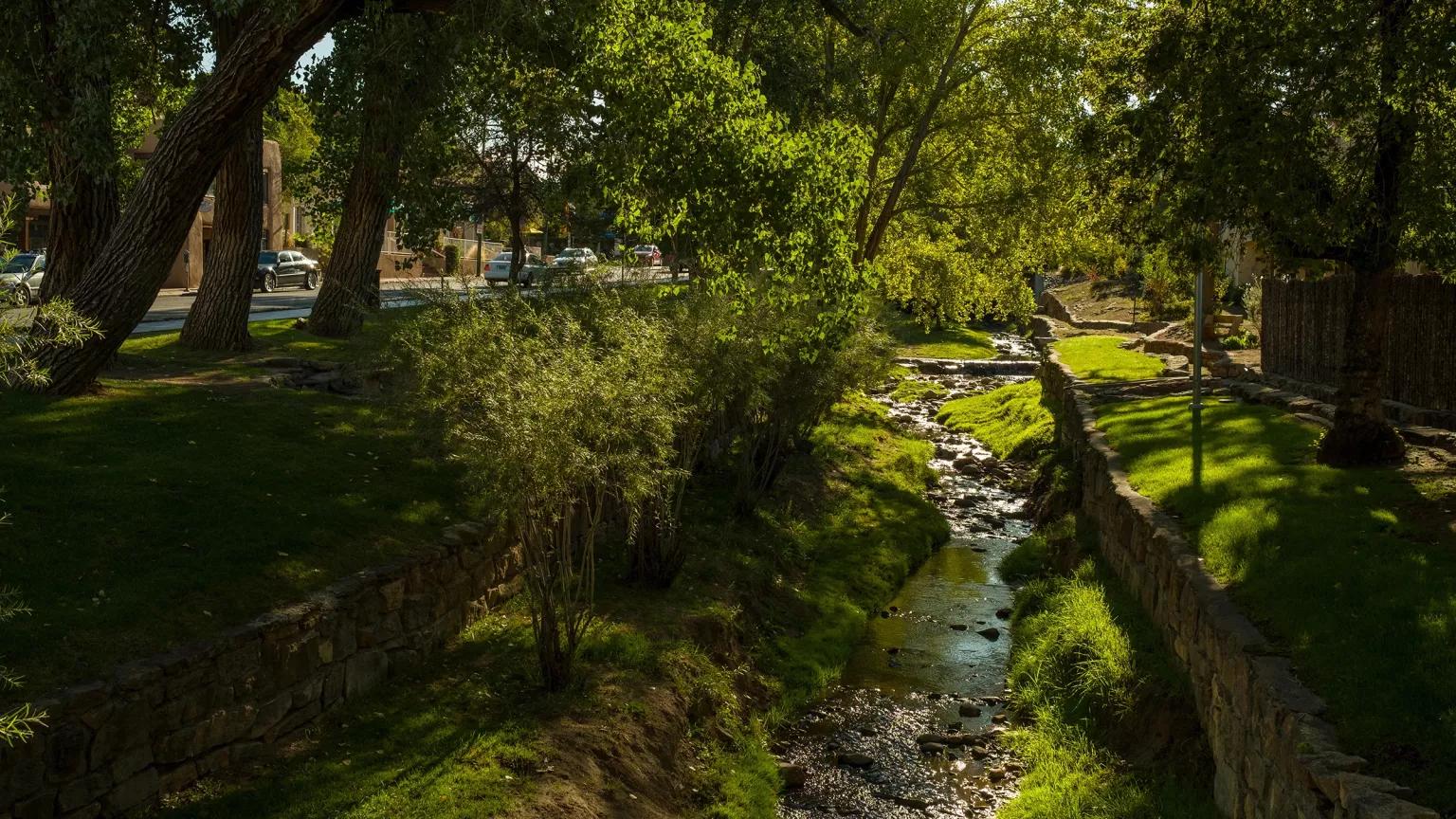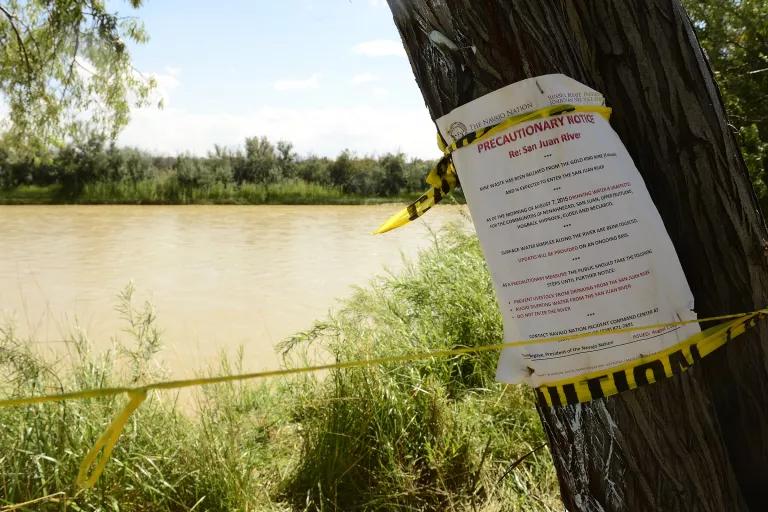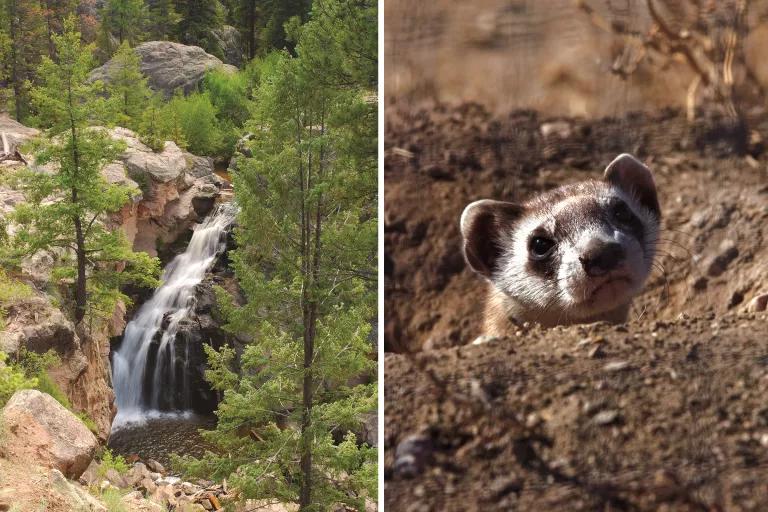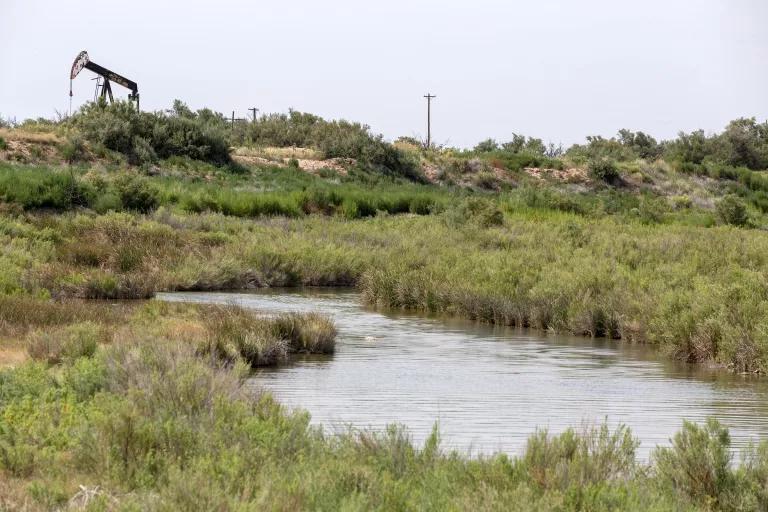New Water Worries in Climate-Stressed New Mexico
Federal rollbacks could leave New Mexico’s limited water dirtier by excluding up to 90 percent of the state’s waterways from protection.

The Santa Fe River flows through Santa Fe River Park in New Mexico.
David L. Moore/US SW via Alamy Stock Photo
At certain times of the year, the Santa Fe River runs so low that it’s possible to walk right across it without even rolling up your pants. The 46-mile river weaves through its namesake city, fed by snowmelt from the nearby Sangre de Cristo mountain range. And despite the come-and-go nature of this waterway, it provides 40 percent of Santa Fe’s water supply.
To help protect the channel from further depletion by dams and agricultural water diversions, in 2012, the city passed a Living River Ordinance. But that could be undermined by a decision from early 2020, when the Trump administration deemed that rain-dependent waterways, like many in the Santa Fe River watershed, no longer qualified for protection under the Clean Water Act.
“The city made a commitment to help ensure the continuance of flows in the river, but now it faces a situation that removes protections, with no assurance of water quality,” says Alex Puglisi, Santa Fe’s environmental compliance specialist.
The Santa Fe River is emblematic of the plight now facing most of New Mexico’s waterways (including wetlands, streams, and rivers), which rely on spring’s snowmelt and summer’s monsoon seasons to fill their channels. Clean water advocates with the Taos-based organization Amigos Bravos estimate that 90 percent of the state’s waters depend on seasonal rainfall.
Many states rely on ephemeral sources that flow only when it rains. But the U.S. Environmental Protection Agency (EPA) wrote these ephemeral water-body types out of its new definition of the “Waters of the U.S.” (WOTUS) in its recent rollback of the Clean Water Rule. By doing so, “the federal government doesn’t have to control discharges of pollution into these waters anymore,” says Rachel Conn, who has been working with Amigos Bravos on water and environmental issues in New Mexico for 20 years.

Signs posted along the San Juan River in Shiprock, New Mexico, warn residents of the dangers of pollution.
Brent Lewis/The Denver Post via Getty Images
In response to these moves to gut federal protections for many of the nation’s vitally important streams and wetlands, a coalition of environmental groups that includes NRDC is now suing the EPA and the Army Corps of Engineers.
A State Unprotected
The EPA manages water protection permitting in New Mexico under the National Pollutant Discharge Elimination System (NPDES) program. That has made the state one of just three (along with Massachusetts and New Hampshire) lacking local authority to regulate wastewater, stormwater, and industrial water pollution within its borders. Previously, under the NPDES program, any entity wishing to discharge pollutants into a New Mexico ephemeral water source typically required an EPA permit.
With the new rule drastically shrinking the types and number of protected waters, many discharges from mines, municipal wastewater facilities, and industrial operations will go unregulated. The facilities will no longer be required to procure discharge permits—and implicitly, says Conn, that also means “no limits on pollution, no required monitoring, no inspections, and no enforcement action.”
The rollbacks will also make it more difficult for citizens to press legal claims of harm under the Clean Water Act—one of the few federal environmental protection statutes that allows members of the public to hold EPA accountable for failing to implement and enforce related permit provisions. Puglisi points out that in the past, NRDC used the citizen suit provision to force the agency to levy more stringent permitting around stormwater regulation to protect water quality standards in New Mexico, just as it did recently in Los Angeles.
“We’re very concerned about the implications of the new ‘Dirty Water Rule’ in New Mexico, a state without laws broad enough to fill the gap,” says Drevet Hunt, a senior attorney with NRDC’s Nature Program. “The agencies charged with protecting waters don’t have the authority, resources, or staffing to fill the void left behind by the reduction in protected water bodies.”
The state must also contend with the significant influence of industry groups and industrial facilities based there, including agricultural and mining organizations, the New Mexico Oil and Gas Association, and Los Alamos National Laboratory (the birthplace of the atomic bomb, located 35 miles from Santa Fe).
“It’s like an industry wish list,” Conn says of the new rule, so holding polluters with a history of fouling the water to account becomes even more crucial.
The Impacts of Climate Change, Compounded
New Mexico’s wet season is critical for replenishing its groundwater sources—which provide the vast majority of its drinking water—as well as the ephemeral sources supplying farms. It also supports wildlife and recreational activities like fishing and swimming.
But with the state “in the bull’s-eye of climate change effects,” as Hunt puts it, New Mexico’s dry season is lasting longer, and the range of intermittent and ephemeral streams is now shorter. Water security challenges are compounded by declining snowpack, an uptick in downstream users, and increasing sources of pollution.
Dozens of threatened and endangered animals, fishes, and invertebrates populate New Mexico’s cliffs and mesas, desert canyons, and thickets of mesquite, acacia, and
juniper. But intensifying wildfires, excessive cattle grazing, logging, and lowered water tables have led to shrinking breeding and foraging habitat for animals like black-footed ferrets, Gila monsters, and golden eagles. The life cycles of these desert creatures are deeply entwined with the water available, Hunt notes. So removing protections for ephemeral tributaries, which will undoubtedly drive up pollution in waterways, puts these species at even greater risk.

From left: East Fork of the Jemez River, Los Alamos, New Mexico; a black-footed ferret
From left: Ron Reznick/VWPics via Associated Press; Ryan Hagerty/USFWS
The Rio Grande mostly flows year-round but intersects with several intermittent and ephemeral tributaries, such as the Jemez River, which flows between the Jemez Mountains. Mining companies in these mountains extract a variety of minerals and stones, including pumice, popular among both landscapers and denim manufacturers, who use the stone for creating a “prewashed” jeans look.
Additionally, ranchers graze livestock along the river’s banks. Mining contaminants, agricultural pollution, stormwater discharges, and industrial dumping in the Jemez—among other ephemeral and intermittent rivers and streams—will increasingly threaten the Rio Grande, which supplies drinking and agricultural water for more than 6 million people and 2 million acres of land.
As a consequence of the government’s Dirty Water Rule, the regulatory and cleanup burden now falls on others—specifically, New Mexico’s taxpayers. Puglisi points out that the city of Santa Fe is required to abide by the Safe Drinking Water Act and the Clean Water Act. Therefore, local officials may need to spend more to deal with water contaminated by upstream sources before treating it for drinking water supplies or discharging it downstream. “It puts a huge burden on us to treat the water to acceptable levels for public consumption and discharge clean water to the Rio Grande,” he says.

An oil pump jack operates near a section of the Pecos River near Carlsbad, New Mexico.
Steven St John/Bloomberg via Getty Images
What’s Next?
To prevent some of the worst impacts of the rule, states would need to increase their own regulatory responsibilities. “For the state of New Mexico, the new definition offers an opportunity to step in and do what probably needed to be done years ago,” Puglisi says. “We’d like to see [officials] develop a state program for the protection of all water bodies.”
NRDC has been working with the administration of Governor Michelle Lujan Grisham to modernize water management systems and address water quality and quantity. These upgrades would give New Mexico additional tools to protect water bodies in the face of a changing climate, Hunt says.
Still, advocates say the state will face significant challenges when it comes to launching its own surface water quality discharge control program. New Mexico currently has a permit program for discharges that could affect groundwater, and its groundwater protection regulations were among the first of their kind in the nation, according to Puglisi. “This permitting program could be extended to waters of the state for surface water discharges,” he says. But such a program would rely on permitting fees and state general funds. “Fees won’t cover the entire program. We’re a large state with a lot of geographical area to cover, and we don’t have the high number of dischargers that other, more densely populated states have,” Conn adds.
In the latest legislative session, representatives of the New Mexico Surface Water Quality Bureau, members of local grassroots groups, and clean water advocates from NRDC fought to increase the bureau’s budget for basic resources, to start filling in the gaps regarding oversight and regulation. “State agencies are already underfunded and understaffed,” Hunt says. “Governor Lujan Grisham is trying to turn that around.”
New Mexico could be suited for a new, recreation-based economy, generating profits through programs that promote fishing, hiking, camping, and swimming. Yet, as Conn points out, the Trump administration’s “dirty-water moves are putting those recreational options at risk.”
And now, she adds, instead of moving forward with developing those opportunities or strengthening the Clean Water Act’s impact on public health, “we’re taking a step backward, toward a time when rivers were literally burning. It’s sad and frustrating.”
This NRDC.org story is available for online republication by news media outlets or nonprofits under these conditions: The writer(s) must be credited with a byline; you must note prominently that the story was originally published by NRDC.org and link to the original; the story cannot be edited (beyond simple things such as grammar); you can’t resell the story in any form or grant republishing rights to other outlets; you can’t republish our material wholesale or automatically—you need to select stories individually; you can’t republish the photos or graphics on our site without specific permission; you should drop us a note to let us know when you’ve used one of our stories.

From Dams to DAPL, the Army Corps’ Culture of Disdain for Indigenous Communities Must End
How to Become a Community Scientist
Biodiversity 101